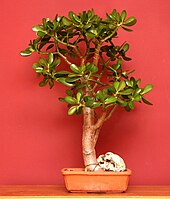User:Satōkaede/sandbox
| Kebab Bush | |
|---|---|

| |
| A 40 year old plant | |
| Scientific classification | |
| Kingdom: | Plantae |
| Clade: | Tracheophytes |
| Clade: | Angiosperms |
| Clade: | Eudicots |
| Order: | Saxifragales |
| Family: | Crassulaceae |
| Genus: | Crassula |
| Species: | C. ovata
|
| Binomial name | |
| Crassula ovata | |
| Synonyms[1] | |
| |

Crassula rupestris, commonly known as kebab bush, concernita bush, bead vine, rosary vine or buttons on a string[2], is a succulent subshrub with short and thick green and red leaves.
Description[edit]
C. rupestris is an evergreen. It has thick, shiny, smooth leaves that grow in opposing pairs along the branches. Leaves are a rich jade green, although some may appear to be more of a yellow-green. Some varieties may develop a red tinge on the edges of leaves when exposed to high levels of sunlight. New stem growth is the same color and texture as the leaves. Although becoming brown and appearing woody with age, stems never become true lignified tissue, remaining succulent and fleshy throughout the plant's life. Under the right conditions, they may produce small white or pink, star-like shaped flowers in the fall.
Numerous varieties and cultivars have been selected, of which C. ovata 'Hummel's Sunset' has gained the Royal Horticultural Society's Award of Garden Merit.[3]
Distribution[edit]
Crassula ovata is native to Mozambique and to the Eastern Cape and KwaZulu-Natal provinces of South Africa.[4]
Cultivation[edit]
As a succulent, Crassula ovata requires little water in the summer, and even less in the winter. It is susceptible to overwatering.
C. ovata may display a red tinge around its leaves when grown with bright sunlight. In more extreme cases, the green colour of the plant is lost and can be replaced by yellow. This is caused by the jade plant making pigments such as carotenoids to protect from harsh sunlight and ultraviolet rays. The jade plant also does best in rich, well-draining soil. The plant also flowers in the wintertime, particularly during a cooler, darker, dry spell. C. ovata is sometimes attacked by mealybugs, a common nuisance of the succulents.
Propagation[edit]
The jade plant is also known for its ease of propagation, which can be carried out with clippings or even stray leaves which fall from the plant. Jade plants may readily be propagated from both with success rates higher than with cuttings. In the wild, propagation is the jade plant's main method of reproduction. Branches regularly fall off wild jade plants and these branches may root and form new plants.

Like many succulents, jade plants can be propagated from just the swollen leaves which grow in pairs on the stems. While propagation methods may vary, most follow similar steps. Typically, the wounds on the leaves are left to dry and callous over. Then, the leaves are placed in or on soil. Roots begin to grow on severed leaves about four weeks after being removed from the stem. Environmental factors such as temperature and humidity affect the speed at which the roots and new plant develop. Foliage usually appears soon after new roots have formed.[5]
Bonsai[edit]
The jade plant is well known for its bonsai capabilities, since it forms a bonsai very easily when pruning is done correctly. Many who learn bonsai begin with a jade plant, since they are durable, easy to put through the bonsai process, and attractive.
Parasites and diseases[edit]
Scale insects are common pests of Crassula ovata and can cause deformation of the plant during growth. An infestation can be eliminated by killing each insect with a cotton bud or brush that has been soaked in rubbing alcohol. This process is repeated daily until all mealybugs have been killed, as well as new insects that may still hatch after the mealybugs living on the plant have been killed. Aphids are also common pests, but they tend to infest the stems of flowers. Spider mites can also cause problems. Exposure to sap or leaves can cause dermatitis in humans.[6]
Cultivars[edit]
- Monstruosa (syn. Cristata, Gollum, Hobbit) – A trumpet-shaped, skimpy branched, shrubby cultivar up to 3 feet (90 cm) tall and around 2 feet (60 cm) wide, with tubular leaves that have a reddish tint. The flowers are small, star-like, and are white or pinkish-white in color. Resembling a small tree, its trunk becomes thick with age. They grow in well-drained, regularly-watered soils in bright airy conditions under a few hours of sunshine in a day, as well as in part shade.[7] They have a superficial resemblance to Sedum rubrotinctum.[8]
- Tricolor – A slow-growing branching shrub with stout stems that has round, variegated bright green leaves which are creamy yellow and white in colour. Drought-tolerant, it still relies on occasional water in summer, but virtually none in winter (unless grown in container).
-
Monstruosa cultivar
-
Tricolor cultivar
See also[edit]
- Crassula arborescens
- Kalanchoe longiflora, a similar looking plant of a different genus but same family
References[edit]
- ^ "The Plant List: A Working List of All Plant Species".
- ^ "Crassula rupestris (Kebab Bush)". World of Succulents. Retrieved 2019-05-23.
- ^ "RHS Plant Selector - Crassula ovata 'Hummel's Sunset'". Retrieved 17 June 2013.
- ^ "Satōkaede/sandbox". Germplasm Resources Information Network. Agricultural Research Service, United States Department of Agriculture.
{{citation}}:|access-date=requires|url=(help) - ^ MD, MD and PhD ( pref. Lewis R. Goldfrank), Handbook of Poisonous and Injurious Plants, Second Edition , Springer,2007, 2 th ed. , XVIII-340 p. , 1 vol. : ill. ; 21 cm ( ISBN 0-387-31268-4 , ISBN 978-0387-31268-2, and ISBN 978-0387-33817-0) , p. 137.
- ^ Botanical Society and Exchange Club of the British Isles 1917 . 1917, p. 617.
- ^ "Crassula cv. Gollum". www.cactus-art.biz. Retrieved 2017-08-02.
- ^ "Crassula portulacea monstruosa". spazioinwind.libero.it. Retrieved 2017-08-02.
External links[edit]
ovata Category:Flora of Mozambique Category:Flora of the Cape Provinces Category:Flora of KwaZulu-Natal Category:Garden plants Category:House plants Category:Succulent plants
{{Crassula-stub}}



